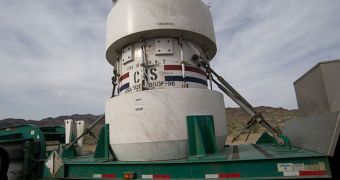An innovative technique that turns nuclear wastes into a type of glass was just announced by investigators with the Faculty of Engineering at the University of Sheffield. The team was able to demonstrate that plutonium-contaminated wastes can be successfully mixed with blast furnace slag to create a type of resilient glass.
In addition to keep radioactive residues safe, this material also compresses the volume of wastes by 85 to 95 percent. The end product is very stable, and can be handled with ease without fear of accident. The research could be used to aid with cleaning the site of the Fukushima power plant.
The tsunami that wracked the nuclear installation has left behind massive amounts of mixed radioactive wastes. By using the new technology, researchers could trap these chemicals as glass, and then easily transport them away to a secure storage site, Science Blog reports.
Until now, nuclear waste disposal involved encasing the dangerous materials in a thick layer of lead and concrete, a process that increased their volume, and made storage a problem. Currently, the research team is working on ways of improving the newly-developed vitrification process.

 14 DAY TRIAL //
14 DAY TRIAL //